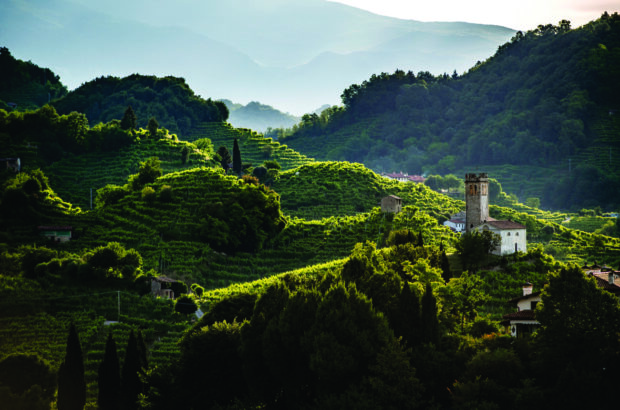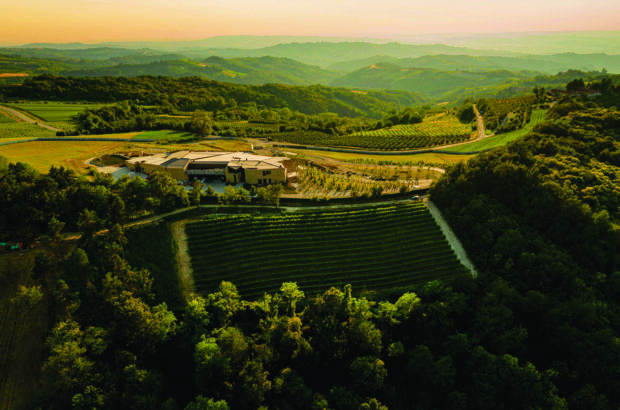The Emilia region in northern Italy is home to all but one of Italy’s DOC and IGT denominations for Lambrusco – a wine name that’s still well known in the UK and US especially, thanks to its heady popularity in its simple, fun fizz guise back in the 1970s and ’80s.
Lambrusco’s historical success has proved to be both a blessing and a curse for the Emilia region, however; while the big players prospered commercially, it made it extremely difficult for smaller producers to emerge into the limelight. It also caused the denial of Lambrusco’s historical role as an effervescent palate-cleanser born to match the cuisine of the Emilia region. ‘Lambrusco turned into a completely different wine from what it was in the local tradition,’ explains Anselmo Chiarli, co-owner of highly regarded producer Cleto Chiarli. ‘Here in Emilia, we have always liked it dry.’
While sweet versions of Lambrusco still prove successful in some markets, most quality-oriented producers are finally shifting to drier styles – either going back to the wine’s roots, or experimenting with innovative techniques to highlight Lambrusco’s versatility. Average quality across the various Lambrusco denominations is constantly improving, with a mix of large wineries and independent growers crafting characterful examples that share food-friendliness as a common point.
Diversity is the key word when assessing Lambrusco: not only do the vineyards stretch from the alluvial flatlands of the Padana plain to the rolling hills of the pre-Appenine area – covering six DOCs in Emilia, a broader IGT and a smaller sub-region in the Lombardy province of Mantova further north – the Lambrusco family also comprises at least 12 different grape varieties.
Style choice
Blending different grapes has always been the norm, yet single-varietal versions of three key varieties have become predominant in recent years, accounting for the vast majority of the premium production. Among them, Lambrusco di Sorbara grabs the most attention. Mostly found in its namesake DOC, comprising 12 villages in the plains surrounding the city of Modena, it is usually defined by a delicate, rosé to light ruby colour enhanced by direct pressing of the grapes or brief macerations, anticipating a delicate, red-fruited and floral nose, and a high-acid and bone-dry mouthfeel.
Lambrusco Grasparossa is widely grown across the entire Emilia region, with the only exception being the tiny Colli di Parma DOC, and boasts a radically opposite personality: deeper-coloured and fuller-bodied, versions labelled as ‘secco’ are generally smoothed out by a touch of residual sugar (12-15g/L) that softens racier tannins; those fitting into the ‘amabile’ category usually contain between 40-50g/L of residual sugar.
Lambrusco Salamino, producing Lambrusco Salamino di Santa Croce in the province of Modena, and also yielding a significant proportion of the Lambrusco Reggiano production, is a happy medium between the two: it has an even inkier colour than Grasparossa and displays similar flavours but the tannins are softer, so it usually requires lower sugar levels to achieve balance.
Local personality
Production methods are another factor that must be taken into account: ever since Cleto Chiarli introduced the first autoclaves in the 1950s, most producers have favoured the Charmat method (secondary fermentation of the base wine in a sealed, pressurised stainless steel tank), which enables a light mousse – no more than 2.5 bars of pressure – to be obtained very rapidly. However, the upsurge in popularity of pét-nat sparkling wines (the ‘ancestral method’, whereby a wine is bottled before it completes its first and only fermentation, which is allowed to restart and complete in the bottle) has fostered the rediscovery of the original way of making Lambrusco, especially in the Sorbara area, and the resulting wines are easily recognisable by their cloudy appearance (the light sediment of spent yeasts) and pleasantly rustic mouthfeel.
Lambrusco di Sorbara also gives some of the best spumante (above three bars of pressure), frequently produced using the metodo classico or traditional method (refermented in the bottle). Cantina della Volta leads the scene in this segment, defying misconceptions that Lambrusco is not suitable for extended ageing, by resting its wines on the lees for at least 36 months.
Emilia boasts an incredible quantity of world-famous recipes. In the region’s chief town, Bologna – also known as La Ghiotta (‘the gluttonous’) due to its immense culinary tradition – tagliatelle al ragú, tortellini with cream or in capon broth, and lasagne take centre stage, while must-try dishes in Modena include cotechino (slow-cooked pork sausage) with lentils, and tortelloni filled with ricotta and spinach. Parma, meanwhile, is renowned for bollito misto (boiled meat with sauces). Lambrusco Grasparossa di Castelvetro Secco (see wine notes below, Fattoria Moretto) always stands out as the most versatile choice with these dishes, where the smooth texture and light tannins allow it to stand up to even the most savoury of flavours.
Emilia’s lofty gastronomic reputation is also linked to the production of some of Italy’s best cold cuts and cheeses. The humid climate of the Padana plain makes it possible to season salumi with less salt, so they always stand out for intense yet delicate flavours and irresistibly creamy texture. Any Lambrusco would pair well with a mixed plate of Prosciutto di Parma, Culatello di Zibello, Mortadella Bologna and Parmigiano Reggiano cheese (all quality, DOP or PGI protected-designation products), traditionally accompanied by gnocco fritto – fried bread dumpling. However, the acidity of an ancestral-method Lambrusco di Sorbara, such as Radice by Paltrinieri, is best suited to balance the fats without overwhelming the flavours.
If looking for non-Emilian food-matching alternatives, pizza is the first dish that comes to mind – crunchy pizza bianca with Mortadella Bologna or ham (and no tomato sauce) is a great match for a crisp and light tank-fermented Lambrusco di Sorbara. Richer pizzas with cheese, tomato sauce and/or salami instead require a bone-dry, red Lambrusco Spumante such as the Lambrusco Salamino di Santa Croce by Cantina Ventiventi (see below), which maximises the cleansing effect with its more energetic mousse.
Flavour horizons

A spicy chilli con carne will match well with the sugar levels in a Lambrusco amabile. Credit: Istetiana / Getty Images
Many producers are trying to promote pairings beyond Italian cuisine, and Japanese recipes seem one of the best options: a top-notch Lambrusco di Sorbara Metodo Classico undergoing longer ageing on the lees, such as Cantina della Volta’s 36, possesses the right combination of fruit weight, aromatic breadth and brightness to complement salmon or tuna nigiri. Ramen is also a great match, sharing sweet-and-savoury flavours with local Emilian broths. ‘Ever since we started organising themed dinners featuring pork ramen and Concerto, a single-varietal Salamino, Japan has been one of the most important markets for us,’ explains Alessandro Medici, co-owner of Medici Ermete. ‘Its dry but fruity mouthfeel enhances the umami taste.’
Finally, higher sugar levels allow Lambrusco amabile to pair well with spicy food: try with chilli con carne or tacos with beef and mole. It’s also the only Lambrusco that doesn’t taste metallic with extra-old DOP Aceto Balsamico Tradizionale di Modena. ‘Finding a perfect wine match for a vinegar over 25 years old is impossible, but at least amabile versions avoid clashing with it,’ says Medici – pour a few drops on aged Parmigiano Reggiano or gelato for a delectable dessert.












